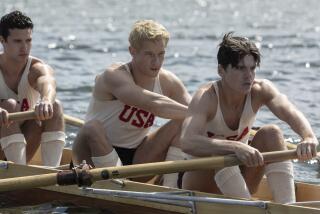Taking the White-Water Challenge
- Share via
COLOMA, Calif. — Sometimes when you look forward to something for a long time, the event turns out to be almost anticlimactic. Not so with river rafting. Two days on the South Fork of the American River were everything I’d anticipated, and a lot I hadn’t.
No rafting experience is required for this class III-rated river. That places it about in the middle on the I to VI International Scale of River Difficulty, defined as easy, medium, difficult, very difficult, extremely difficult and unrunnable.
Day 1 on the river was scheduled to begin early. Our group drove from Los Angeles to this town about 40 miles northeast of Sacramento the day before. We arrived in time to scout the area, then camped overnight, some of us under the stars and others in tents.
We met our river guide, Dan Little, at breakfast the next morning. The veteran in our group had made several trips with him, so even though he was flipping pancakes and telling bad jokes, I took her word that we’d be in good hands.
Words of Wisdom
That was reinforced at the orientation after breakfast when he began tutoring us on how to use our paddles for propulsion, as protection from rocks on any unscheduled exit from the raft, and for help in getting back into the raft. If we found ourselves in the water, we were instructed to float on our backs with feet up in front of us for protection against floating into rocks.
Using a miniature, Little explained the term wrap, when the raft bends around a rock. With quick action, rafters can weigh down the high side and force the craft back down into the water and around the obstacle. His obvious command would be “high side,” and we were to move fast.
These points and a lot more information were conveyed in a manner that suggested the inherent dangers of river rafting, yet didn’t reduce us to shaking in our shoes. Next we were outfitted with life jackets, adjusted so they couldn’t ride up over our heads if and when we were in the water. Each of us was also issued a paddle.
If any of us still had any doubt about this being a participatory voyage, it disappeared as soon as we learned about portage. Simply put, that means carrying the boat. Up over our heads it went and off we staggered to the river. It’s a good thing it wasn’t far . . . I never would have made it.
About the time we were leisurely enjoying breakfast, water began to be released from a dam upriver; our departure was timed to take advantage of the increased flow. It wasn’t difficult for even those of us without experience to detect the difference in noise level when that water reached the river next to our camp.
About 10:30 a.m. our group climbed into two rafts and tried our paddling skills in the eddy of calmer water. Then the command was “all forward” to move us into the current that headed downstream. Behind us came the second or “sweep” raft, which in addition to its guide and crew of eight, carried first-aid equipment.
My raft carried eight and Little. We ranged in age from 13 to 62: two men, a teen-age male and six women. Only two of the women and our guide had any rafting experience.
The river started out easy, and as we passed some homes and meadowland, Little led us through a few paddling maneuvers. It wasn’t difficult to see that behind his casual facade was a knowledgeable and perceptive mind. Little has been a guide for 10 years, and probably knows the South Fork as well as we know the street where we live.
Following Orders
By the time we came to our first rapid Little knew the capabilities of his crew and chose a route that we could manage. Of course we heard the rapid before we saw it, but if I felt any fear, it disappeared quickly when I heard Little’s voice and became totally involved in following his commands. Paddling through the white water gives you added stability.
People often compare rapids to a roller coaster, but I don’t agree--it’s a less controlled feeling because the raft tips and bends, and rocks bump against the bottom. On a hot sunny day the spray of water that accompanies this action is invigorating.
Quickly the rapid was past and we were back in calm water. Nobody had fallen out; one down, 49 more rapids to go over the 20 miles we would navigate in the two days.
The good news is that every rapid was followed by a stretch of calm water; the bad news is that you often have to paddle those areas. River rafting in a paddle craft turned out to be far more physical than I had expected.
Between negotiating a few more rapids we were also initiated into the art of water fighting. That’s when a companion raft attacks at ramming speed and starts dumping buckets of water over your heads. Prime targets are women who got up that morning and took the time to arrange their hair rather than just shoving it up under a hat.
From there the list extends on down to anyone else in the water’s path. On a hot day it feels pretty good, and because it’s about as much a part of rafting as the white water, you might as well enjoy the fun and throw some water back.
After stopping for a deli lunch on the river bank we headed into the gorge and Haystack, our first big rapid. It was only Little’s strong arm that kept me in the raft on that one. At Satan’s Cesspool two of our crew made involuntary exits and we had our first experience at rescue. We took refuge in an eddy to catch our breath before continuing downstream.
Guide Overboard
Little’s commands continued to be on target, and I came to realize the importance of his timing. He knew just how long it would take us to respond, and how much action it would take to get us into the correct position to get around a rock or through a rapid.
Two more members and even Little exited somewhere around Bouncing Rock, but I repaid my debt by grabbing Little in a hurry. No way did I want us to go far without a guide. Down through Hospital Bar and Recovery Room rapids we went, perhaps without great form, but we made it with only minor cuts and bruises.
As we approached Salmon Falls Bridge and the end of the first day, some of us celebrated by jumping into the river, lying back on our life jackets and drifting along in the current. It carried us rapidly downstream, while a wind made paddling rough for those back in the raft.
But we paid our dues with another portage stint, this time carrying the raft up a hill and loading it on top of the bus.
We had been on the river 6 1/2 hours, but after the ride back to camp and hot showers, most of us were revived, at least for a while. How our guides found the energy to help cook dinner that night was a wonder. We indulged ourselves on steak and chicken, corn, baked potatoes, sauteed vegetables, salad and garlic bread. Later those same guides entertained us with music and juggling.
Challenge of Day 2
Day 2 was to be spent on the more challenging section of the river. Two of our crew didn’t go, not out of fear but because each felt it would be best for his well-being. One was a recovering cancer patient, the other had taken the hardest exit from the raft the day before. “I’m old and I’m wise,” was his explanation. So this time our crew was six women, one teen-age male and Little.
The bus drove us up to Chili Bar where we unloaded the boats and carried them to the water. As soon as we were underway it was evident that the lessons of the previous day had sunk in--we may not have been the best team on the river, but we had improved.
We went through Meatgrinder, Racehorse, Maya, Rock Garden and Triple Threat without even an involuntary exit. We survived a water fight from two other rafts at once. And, most of all, we experienced a lot of thrilling rapids and plenty of laughs.
As we approached Trouble Maker, the biggest and last rapid, we knew the photographers would be there taking pictures.
“Let’s do it right. We don’t want to embarrass ourselves,” someone said. We didn’t. As we paddled back down to camp a little while later, most of us were making plans for our next white-water adventure.
-- -- --
Dan Little is a guide with River Runners, 23801 Killion St., Woodland Hills 91367, (818) 340-1151. The cost of two-day trips on the South Fork of the American River are $160 on weekends and $125 midweek for adults, $145 and $115 for children 12 and under. The minimum age is 7 or a weight of at least 60 pounds. Basic swimming skills are highly recommended. Trips are offered April through September.
More to Read
Sign up for The Wild
We’ll help you find the best places to hike, bike and run, as well as the perfect silent spots for meditation and yoga.
You may occasionally receive promotional content from the Los Angeles Times.






